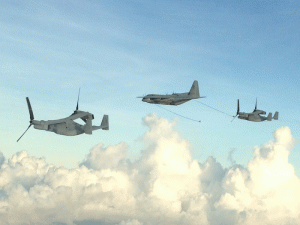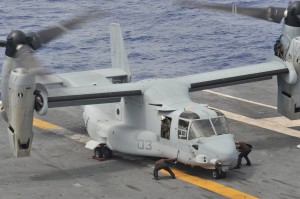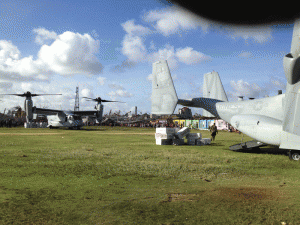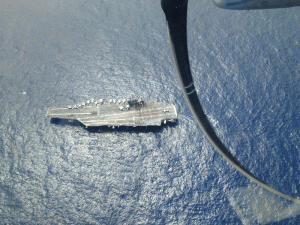2013-11-20 By Robbin Laird and Ed Timperlake
Joseph K. Taussig, a distinguished US naval officer, on arriving in Ireland with the first American naval vessels to get to Europe after the US declaration of war in WWI stated: “We are ready now sir.” The Marines based in Okinawa have demonstrated that same approach towards the relief mission in the Philippines.
Americans and others around the globe have seen the moving images of Marine Ospreys and KC-130Js initially based in Okinawa arriving quickly to aide relief efforts in the Philippines. The Marines are the only force other than Special Operations that uses their C-130s as tankers (hence KC) and this allows for extended missions for the Ospreys.
These ready on arrival Marines in the aftermath of a horrific Typhoon were the initial tip of the spear of a US relief effort, called Operation Damayan.
As one senior Marine has put it:
1st MAW had Ospreys and Hercs in Tacloban about 72 hrs after the storm passed. And I am not talking just about people on the ground but real, self-sustaining capability to move the mountains of relief supplies to where it was needed and where nothing else could get the job done so effectively.
There is no question it is a just a small effort against an immense catastrophe but the combination of rapid deployment and true capability is a crucial part of getting the response in play.
Only a few months ago, the Ospreys had come to Okinawa, and did so in the face of significant orchestrated public protest to their arrival.
Now they are a unique lifesaving asset of the initial engagement of American forces in the effort.
The Marines themselves make it very clear that they are only part of US and world relief effort, and laying down the initial template for ramping up the efforts of other US and allied forces as well as the civilian agencies.
In the aftermath of a Typhoon, chaos is the initial problem. The military is a core tool for bringing order out of chaos and getting the relief effort started. And getting it started is what the USMC engagement in Operation Damayan is really all about.
We had the chance to talk with a key participant in the initial engagement and learned from him how the process was put together and how it has proceeded.
Lt. Col. “Sniper” Brown is the CO of the “Flying Tigers” or VMM-262.
In fact, the heritage of VMM-262 is that of HMM-262, a squadron with a distinguished combat history.
VMM-262 became designated an Osprey squadron in a ceremony at the end of August of this year.

Two months later, the new squadron of Ospreys was getting ready for a major test not in combat but in humanitarian aide.
This is the squadron’s fourth re-designationn since its activation in 1951. It has supported operations in Lebanon, the Dominican Republic and Vietnam from its duty station at Marine Corps Air Station Cherry Point, N.C. It relocated to MCAS Futenma in 1992, going on to participate in humanitarian assistance and disaster relief efforts in Indonesia, the Republic of the Philippines and Japan.
“For more than 60 years, 262 has earned many honors … I’m confident that their great legacy will continue,” said Col. Brian W. Cavanaugh, the MAG-36 commanding officer.
And it is and this time baptized by engaging in typhoon relief. The impact of the Typhoon is a good reminder of the reality of the Pacific. The key to understanding any human conflicts in the Pacific is to first recognize both the natural power and size of that Ocean.
The Pacific is nothing like the name “Pacificum” or peaceful in Latin. It is a violent and expansive Ocean. Rounding the tip of South America.
Ferdinand Magellan, in perhaps one of the more significant “name branding” mistakes in history pronounced the body of water he saw as peaceful.
The question of how dangerous and violent is the Pacific was answered by Sir Francis Beaufort in the 19th Century in his code measuring storms at sea “The Beaufort Scale.”
After being wounded several times and commanding a Royal Navy ship of war Beaufort became Hydrographer of the Royal Navy for twenty-five years. In fact some of his charts are still used to this day. Sir Francis was a visionary who specifically recognized the strategic importance of the entire Pacific and he also focused on the strategic importance of the Arctic.
His “Beaufort Scale” runs from 1 to 12 with a Force 12 being “Hurricane Winds.”
“Huge waves and sea is completely white with foam and driving spray greatly reduces visibility.”
However, in 2006 the Peoples Republic of China adopted a scale that goes to a high of 17 to acknowledge what they saw as the power of a tropical cyclone off their shore known as a “Chinese Typhoon.”
Consequently, all ocean going mariners, from early explores on war canoes, to Chinese Junks, to European sailing vessels to modern battle fleets must have a very healthy respect for the pure raw power and also extremely significant distances involved with the Pacific Ocean.

A famous World War Pacific Typhoon makes that startling point. Historians have debated the number of USN Ships sunk by Japanese Kamikaze attacks during all of WW II in the Pacific. Their counts vary from a low of 34 to a high of 47.
Compare that Kamikaze fight against a reactive enemy over a almost a four year war with a US Task Force caught in a Pacific Typhoon in one 24 hour period.
In the Pacific Typhoon of December 18, 1944 three Destroyers capsized; the USS Spence, USS Hull, USS Monaghan, with the loss of most of their crew–over 700 hundred sailors perished. Additionally, 146 aircraft on Fleet Carriers were struck from the rolls because of damage.
A typhoon can ravage a society and tear through its essential core.
Managing disruption becomes a key challenge along with getting in the immediate relief needed for the survivors to do just that—survive.
And the initial engagement is really the launch point for reconstruction to come; not done rapidly or effectively enough not only do people die but the chaos continues much longer than necessary which turn creates severe challenges for reconstruction.
In an interview with “Sniper” Brown late on Sunday November 17th when he had returned from the day’s activities to Clark Airfield in the Philippines, the CO provided insights into the process and challenges facing the Marines.
As it became clear that a Typhoon would hit the Philippines, the Marines began to organize for a possible relief effort. This meant changing gears from preparing for a relaxing holiday weekend (celebrating the USMC birthday through to Veteran’s Day) to ensuring that personnel and planes would be ready for action.
For Brown, it started with working with his next-door neighbor, Lt. Col. “Julio” Julian, the CO of the Sumos, the KC-130J squadron (VMGR-152) stationed at Marine Corps Air Station Futenma, in Okinawa, Japan.
It meant getting the maximum number of Ospreys in his squadron ready for action. Two of his 12 planes were in heavy maintenance cycle, and they needed a 4-ship group for the initial operation. They had 5 ready when first contemplating a response (ready for tasking); the other five were in process of being prepared for operations. The maintainers worked hard to get additional planes ready, which meant that two 4-ship groups would be ready for the initial engagement. The plan was to have the planes ready for operation by the 10th the day of the USMC birthday ball.
“When we realized that the storm was going to be as strong as it was, we knew we needed to have the 10 planes ready to go out of town. Over just two shifts of maintenance we had 10 birds ready to go. We then waited for the official launch order, but we were ready to go.”
They needed to shape an initial engagement plan as well.
“We knew we would enter a situation of chaos in the ground. We planned for our initial operation and got our planes and personnel ready. That is all that you can do when you don’t know what is about to happen. I had this experience when working on New Orleans relief after Katrina, so I had a sense of how immense the devastation from such an event could look like.”
When the call to fly into the devastated areas came on Veteran’s Day weekend, the challenge was to put together the ability to fly. “We flew with the Sumos who kept us fueled and carried our logistical needs as well. But we needed to sort out where to go and what the priorities would be in the initial 72 hours.”
According to Brown, the first mission was go to Villamor Airbase, the home of the Philippine Air Force. They went there because it has significant storage of supplies as well as a command post. “We dropped off a couple of liaison officers as well on day one. We did not know what to expect, or where to go day one.”
When they faced day two they did not know what to expect.

“But we were up and running and flying by 0830 on a four ship on day two. We went to Villamour to pick up supplies and then had to determine where to take those supplies.”
Brown highlighted that the disruption of the networks was significant as well, which meant that the satellites and other communications and support systems were in scarce evidence. Anticipating a lack of normal support on the ground such as even electricity, the CO had his Ops team put together a flight schedule for a weeks worth of operations. When the “hold tight” became the go order they were ready when they landed to immediately fly to the people suffering.
“Major “Papi” Guzman who is my assistant operations officer and with whom I flew lead and wing together interchangeably for the first three days and I looked at a story in the Philippine Inquirer newspaper and said lets go to where they said a town was destroyed. We operated with visual reconnaissance to determine where to go and when. At one point we read the local paper to determine which Island needed us most. We decided to fly to Guian peninsula, and when over Guian decided to land on what looked like a soccer field. But it turned out to be a school, with hundreds of children on the field.”
We asked Brown what happened when they landed in the schoolyard?
“The first thing were a met with is hundreds of kids. I looked at this and thought of my own children. What if these were our kids? Our crew chief started offloading supplies; the kids are waving at us and smiling to us. The local police walked out and then the crowd organized itself into a nice orderly line, even though they have not had food or water for 3 or 4 days. It was amazing to behold. We were blown away by it for we were expecting a press of bodies from the crowd; but they were lined up and waiting for their turn. Amazing.”
In a situation of ground chaos, sorting out the priorities for taking supplies to target points is a key challenge.
“Captain Casey Nelson and his crew did an emergency medevac of a 16 day old baby girl who was dying. They flew here to Manila for emergency treatment and she survived. The co- pilot was a young pilot with 30 hours of flying experience in the squadron. They had to fly alone and over water even though not an experienced crew.
We are a young squadron and our maintainers and support personnel are incredibly dedicated to the round the clock job which we face.
When we return from our relief flights we provide pictures to the ground crew so that they can see whom they are supporting and helping.”

As the operation has gone on, and additional military capabilities are arriving, the Marines have been working to put together an operational support structure.
““The MAG-36 HQ have put together a hub and spoke system.
We have Marine FARPs on the ground, which support USN helicopters from the USS George Washington. The Ospreys are using the KC-130s or the carrier as our fuel support structure. It is a question of being closer to the need rather than having to follow classic support efforts. With the speed and range of the Osprey, the USN and USMC can change how it puts the operational mix of aircraft together.”
Brown’s background is initially that of being a Ch-46 pilot.
We asked him how the Osprey operates differently from the CH-46 in a mission like this and how it worked with the KC-130Js.
He went back to his initial Osprey experience of flying the plane into Afghanistan for the first combat engagements of MV-22 in that theater of operation with the Marines.
(For our overview story at the time on the introduction of Ospreys into Afghanistan please see the following:
https://sldinfo.com/going-to-afghanistan-the-osprey-squadron-prepares/).
“We did in 2 ½ hours a flight that the CH-46 would do in 2 ½ days. Here the challenge would have been the impact of the storm. The CH-46s would need to operate from various islands or forward operating support areas and would have been strewn over the area, rather than the concentration of capability, which we could bring with the Osprey.
It would have taken an entire day with helos strewn across the Pacific. Or the Navy would have to float an amphib to operate near the relief area. It is not just time but the ability to work seamlessly with the KC-130s, is crucial. Obviously, they can go much farther than we can but we fly at about the same cruising speed so it makes it easy to operate together. The KC-130s carry our gear and maintainers as well. They are very complimentary aircraft for such an operation.”
The Marines are the initial force shaping an integrated entry force into the crisis.
As the USAF and the USN generate assets, the template set up expands to encompass the next phase of operations.
For example, the relief forces can now operate over a 24-hour lift cycle as the USAF has brought in its specially equipped C-130s and starts to bring in its C-17s.

Training is a crucial part of getting ready for an operation like this one.
“Recently, we trained at Clark Airbase with the KC-130Js and the Philippine Air Force in an exercise. We came to Clark and took up the same slots and facilities we used a month before during the exercise to conduct our mission here. Clark had not taken damage so we have been able to operate from Clark.”
Currently, the Flying Tigers have 8 Ospreys at Clark and the Sumos have 6 KC-130Js.
It is evident as well that the Philippine forces have been central to the relief effort.
“Many of our colleagues have lost family throughout the islands. They are working hard to help their people. When you land with relief aid, the Army comes and carries the loads on their backs and helps to distribute the supplies. We see every day during or dawn to dusk flights incredible energy and bravery by the Filipino people to turn this thing around. The Philippine Air Force is getting their equipment working and engaged in the effort.
They have their old American 2 ½ ton trucks, and these 100-pound Filipinos off load the supplies, and form a human chain to get the supplies where they need to go.
When I flew over New Orleans and saw the destruction there, it reminds me of what I am seeing here – it is just gone.
Neither crisis is an easy one to deal with or get past quickly.”
“Sniper” Brown was preparing for his wedding anniversary when he learned about the need to scramble.
An alternative title could have been for this piece” “Hold the Anniversary, Darcy. We are off to deal with a Typhoon.”
For a PDF version of this article to download:
Second LIne of Defense Coverage of the Philippine Relief Effort to Date:
https://sldinfo.com/we-are-ready-now-sir-the-21st-century-version/
https://sldinfo.com/getting-the-initial-job-done-time-is-the-most-precious-commodity/
https://sldinfo.com/preparing-aid-for-delivery-in-operation-damayan/
https://sldinfo.com/establishing-a-farp-guian-during-operation-damayan/
https://sldinfo.com/sorting-through-supply-packages-to-support-relief-in-the-philippines/
https://sldinfo.com/lt-gen-wissler-visits-tacloban-air-base-after-typhoon-haiyan/
https://sldinfo.com/marines-in-airlift-support-at-tacloban-air-base/
https://sldinfo.com/more-osprey-photos-from-philippines-relief-operation/
https://sldinfo.com/flying-tigers-engage-in-support-of-the-philippine-rescue-effort/
https://sldinfo.com/the-history-of-the-flying-tigers/
https://sldinfo.com/multi-national-relief-aid-in-tacloban-during-operation-damayan/
https://sldinfo.com/usmc-provides-initial-airlift-for-philippine-rescue-effort/
https://sldinfo.com/from-protests-to-leveraging-its-presence-the-osprey-in-japan/
https://sldinfo.com/ospreys-and-c-130js-depart-from-villamor-air-base-manila/

